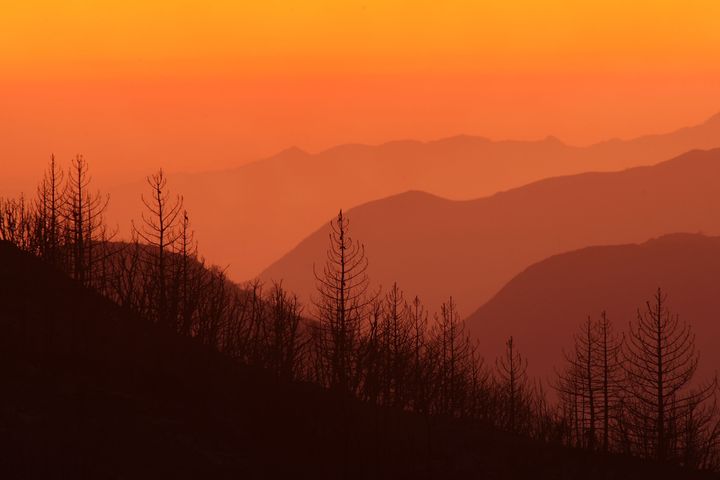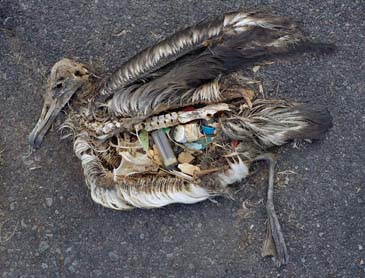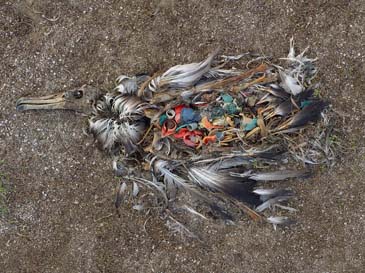
A Kick in the Gut: Chris Jordan's Midway - Photos from the Gyre
Chris Jordan is a photographer who creates stunningly memorable images by exploring "the detritus of our consumption ... with awe and fascination." You may have seen some of his other well-known artwork in his series on Katrina, or Running The Numbers.
His most recent work is a gut-wrenching exhibit of photos made on the islands of Midway in September 2009. The images are a collection of unaltered photos showing the dead carcasses of baby albatross, with piles of plastic where their bellies should be. Just released last week, these photos are shocking homage's to the real life damage that comes from the careless disposal of plastic waste.

Midway is part of the Hawaiian chain, but its way out there. Jordan and his small crew took a 5-hour plane ride from Honolulu in a government prop jet to one of the most remote places on earth. 2000 miles from the nearest continent, nearly 2 million birds of 19 different species use the atoll of three islets as nesting grounds. Midway was a strategic US Naval Base until 1996 when it became a National Wildlife Refuge. It is also located inside of the Pacific Ocean Gyre, where currents swirl together the world's floating garbage into what is known as the Plastic Vortex, or the Pacific Ocean Garbage Patch, first discovered by Charles Moore.
I spoke with Chris Jordan Friday October 30, 2009 about his newest art. He explained that his work "follows a theme of trying to shine a light on things that are invisible, hard to relate to, and hard to visualize." He first learned about the Plastic Vortex about a year ago, and saw some photos made by biologists of dead Albatross that had ingested plastic debris. He said, "I noticed myself not trusting the image, wondering if they added garbage. Was the belly really that full of plastic?" He set off to find out. After a difficult process of obtaining the correct permits, he saw for himself. Yes, the bellies really were that full of plastic.
Jordan made the creative decision to shoot his photo series in a way that would show the exact reality of what was there. He would not add, alter, move, or manipulate a single piece of plastic. "It was hard" he said, "there were pieces of recognizable plastic, happy meal spoons, lighters in the shape of naked women," pieces that could have added to his theme. But he knew he had to stay true to his decision, and be able to authentically say he had not changed a thing. He wondered about how the images would appear artistically. He chose to shoot the carcasses centered in the frame, without tricks of light or shape to draw the eye in. The result, I believe is extremely powerful art - a strange mixture of reverent beauty and horror that one cannot help but be affected by.
"When we find lethal quantities of plastic on the most remote island on earth, its like a doctor telling you that your cancer is in your lymph nodes. By implication it is everywhere," Jordan says.
Perhaps this kind of artwork will provide a jolt for changing our deadly human behavior. We humans have been in a comfortable denial, enjoying the convenience of throwaway items with no thought to the consequences. Now we face a planet despoiled by toxic plastic. Plastic that is created by a dwindling supply of fossil fuels, fuels that are altering the makeup of the very air we breathe, as well as changing our climate.
Jordan says:
As an American consumer myself, I am in no position to finger wag; but I do know that when we reflect on a difficult question in the absence of an answer, our attention can turn inward, and in that space may exist the possibility of some evolution of thought or action."
The truth is, its not that hard to conserve. We can all start by bringing our own coffee and water cups to work, the beach, or wherever. We can keep plenty of reusable bags handy and stop using plastic ones. The Guardian UK reported last May that China saved 1.6 million tons of oil in one year when they put restrictions on plastic bags.
Those are just some of the steps we can make towards a less wasteful and more sustainable society. When you look at these birds that died from their meals of plastic - what will you do?
For more information on Chris Jordan's exhibits and upcoming book of Midway photos and poems written by his wife, Victoria Sloan Jordan, see his website.

